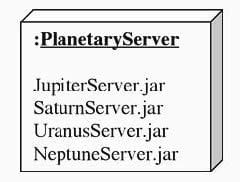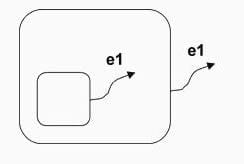Exam Details
Exam Code
:OMG-OCUP-200Exam Name
:OMG-Certified UML Professional IntermediateCertification
:OMG CertificationsVendor
:OMGTotal Questions
:154 Q&AsLast Updated
:Mar 25, 2025
OMG OMG Certifications OMG-OCUP-200 Questions & Answers
-
Question 11:
In the exhibit, what is true about the deployment location?

A. is over-crowded
B. is at the "type" level
C. is at the "instance" level
D. is parameterized by four DeploymentSpecifications
-
Question 12:
What is true when an event does not trigger any transitions in the current state?
A. An exception is raised.
B. The event is discarded.
C. The state machine is not well formed.
D. The handling of the situation is a semantic variation point.
E. The event is deferred until a state is reached that responds to that trigger.
-
Question 13:
Triggers on two different transitions originating from two states at different levels of the same state are simultaneously enabled (as shown in the exhibit). What does this mean?

A. The state machine is not well-formed.
B. Both transitions are taken in arbitrary order.
C. More deeply nested transitions take precedence over those with less depth.
D. The less deeply nested transition takes precedence over those with more depth.
-
Question 14:
What is true of a local transition of a state?
A. equivalent to an internal transition
B. any transition that occurs only in that state
C. a transition that cannot be triggered if no substate is active
D. a transition that will not execute the exit and entry actions of the state but only those of its substates
-
Question 15:
What does a run-to-completion processing for state machines mean?
A. The executions of orthogonal regions are serialized.
B. Interrupts are disabled while the state machine is running.
C. No other event will be processed until the current event is fully processed.
D. The thread executing the state machine cannot be pre-empted by the scheduler.
-
Question 16:
What is implied when a transition terminates on the outer border of a composite state that has an initial and a history pseudostate?
A. The state is not entered.
B. The outgoing transition from the final pseudostate is taken.
C. The outgoing transition from the initial pseudostate is taken.
D. The outgoing transition from the history pseudostate is taken.
-
Question 17:
What is true when deferrable triggers of a state specify triggering events?
A. are of lower priority
B. are ignored in that state
C. will be consumed after the state is exited
D. will be consumed when a state in which they are no longer deferred is reached
-
Question 18:
What does a state list represent?
A. notational shorthand for a set of states
B. list of the substates of a composite state
C. set of states that share a single outgoing transition
D. set of states that share the same entry and exit actions
-
Question 19:
What is true for an exit action of a state?
A. occurs when final substate is reached
B. occurs after the "do" action of a state completes
C. is executed before the exit actions of any containing states
D. will be bypassed if a transition on a containing state is triggered
-
Question 20:
What does reaching the terminating pseudostate mean?
A. The final state has been reached.
B. The enclosing region is completed.
C. A completion transition has occurred.
D. The "do" activity of the current state has completed.
E. The context object of the state machine is terminated.
Related Exams:
OMG-OCSMP-MBA400
OMG-Certified Systems Modeling Professional - Model Builder - AdvancedOMG-OCSMP-MBI300
OMG-Certified Systems Modeling Professional - Model Builder - IntermediateOMG-OCUP-100
OMG-Certified UML Professional FundamentalOMG-OCUP-200
OMG-Certified UML Professional IntermediateOMG-OCUP-300
OMG-Certified UML Professional - AdvancedOMG-OCUP2-ADV300
OMG Certified UML Professional 2 (OCUP 2) - Advanced LevelOMG-OCUP2-FOUND100
OMG Certified UML Professional 2 (OCUP 2) - Foundation LevelOMG-OCUP2-INT200
OMG Certified UML Professional 2 (OCUP 2) - Intermediate LevelUM0-100
OMG-Certified Uml Professional - FundamentalUM0-200
OMG-Certified Uml Professional - Intermediate
Tips on How to Prepare for the Exams
Nowadays, the certification exams become more and more important and required by more and more enterprises when applying for a job. But how to prepare for the exam effectively? How to prepare for the exam in a short time with less efforts? How to get a ideal result and how to find the most reliable resources? Here on Vcedump.com, you will find all the answers. Vcedump.com provide not only OMG exam questions, answers and explanations but also complete assistance on your exam preparation and certification application. If you are confused on your OMG-OCUP-200 exam preparations and OMG certification application, do not hesitate to visit our Vcedump.com to find your solutions here.